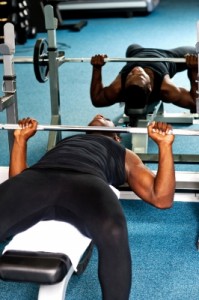The bench press is the de facto standard of upper-body strength for many gym-goers all over the world. If you have been training consistently for a long time and have a good physique, many others will not ask you how much you can squat or dead lift – rather, they will ask you about your bench numbers.
Getting your bench numbers up, however, is not just an ego booster. If you have a good bench press, you probably have a strong upper body (unless you’ve been neglecting doing pull-ups or rows). The movement does not only involve the chest and triceps, but also the shoulders, forearms, and upper back. Adding pounds to your bench will require you to strengthen the weak links among these muscle groups, especially the shoulders which are prone to injury. Good form is essential to making long-term progress and safety with this lift.
The best assistance exercises for the bench press involve dumbbells. Using dumbbells will allow you to train the muscles that keep the bar stable under heavy loads, and give you more room to develop flexibility and improve your form.
Incline dumbbell presses mimic the bar movement enough while allowing you to use less weight yet feel a similar level of resistance. Many bodybuilders also use the incline position more than the flat position since it targets the upper pectoral muscles which are more prominent than the middle chest. If you are a powerlifter, you can do heavy benches first and then do two to three sets of eight to ten repetitions on the incline dumbbell presses to get in more volume.
To target the shoulders, dumbbell overhead presses are the best since you can execute a full range of motion (full discussion in this article) without a bar restricting the natural rotation of your arms. Using this range of motion allows you to target all shoulder muscles and not just the front shoulders.
The triceps are one of the primary limiting factors to bench press strength. Getting stronger triceps will definitely improve your bench numbers. The best exercises for the triceps are the heavy close-grip bench press and bodyweight or loaded dips. For the close-grip benches, you should be using a weight that is less than your bench work weight, but with which you can complete eight to ten challenging repetitions. Two sets should be enough to get the training effect you need after doing heavy bench presses beforehand.
The upper back should also be in balance with the chest muscles in strength since an overemphasis on the chest will produce posture imbalances that could lead to injury while training. Pull-ups and barbell rows can give the necessary balance to heavy benches. Two sets of around eight repetitions should be enough, but you should be training your back on other days as well.
Finally, it is important to not bench too often. You can alternate between overhead barbell presses and flat bench presses along with these assistance exercises in your workouts to give your muscles the time and stimulus they need to grow optimally.
Photo credit: stockimages, freedigitalphotos.net











